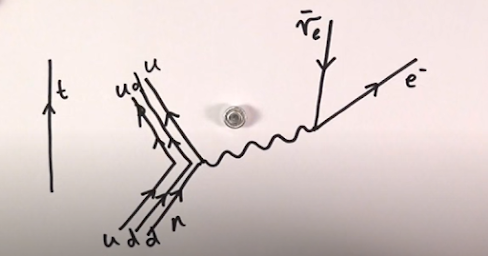More on the Standard Model and its components (Including an introduction to Higgs Boson)
MORE ON
THE
STANDARD MODEL
AND
ITS COMPONENTS
View my previous article here -
View the next article here -
-----------------------------------------
(It is recommended to view the previous article to understand this article better)
We know that atoms are made of electrons, protons and neutrons. If we further zoom into the protons and neutrons, we find that they are made of subatomic particles known as QUARKS.
- The proton consists of 2 UP QUARKS and 1 DOWN QUARK
- The neutron consists of 1 UP QUARK and 2 DOWN QUARKS
Thus, everything we see around is simply made of quarks and electrons; more specifically - up quarks, down quarks and electrons.
These were the first three particles in the Standard Model.
The next particle that was added to the Standard Model was the electron neutrino.
- Neutrinos are almost invisible, extremely small, almost undetectable particles.
- Although they are produced in trillions by the sun and travel through our body, it was hard to detect them because they rarely interact with the matter that we are made up of.
So, how were these neutrinos actually even detected?
Coming back to the Standard Model, now we had 4 particles that were classified under the first generation.
- Up Quark (Quark), Down Quark (Quark), Electron Neutrino (Lepton) and Electron (Lepton).
Next, we found 4 more particles that made the 2nd generation.
- Charm Quark (Quark), Strange Quark (Quark), Muon Neutrino (Lepton) and the Muon (Lepton).
- These were the same as its corresponding 1st generation particle; however, they were more massive and unstable.
- They quickly decay into their corresponding first generation particles.
- These particles are made by high energy collisions.
Then, there were another 4 particles that belonged to the third generation.
- Top Quark (Quark), Bottom/Beauty Quark (Quark), Tau Neutrino (Lepton) and Tau (Lepton).
- These are heavier than the 2nd generation particles.
- They too quickly decay into their corresponding first generation particles.
Next in the Standard Model are the force carriers of the fundamental forces.
4 fundamental forces are at work in the universe.
However, the Standard Model only describes three of them -
- Electromagnetic force - the force that binds the electrons to the nucleus. Its force carrier (i.e. boson) is the photon. Yes, this is the same photon that makes up all light and is also the basic unit for radiation (radio waves). This is why light is considered to be an electromagnetic phenomenon.
- Strong nuclear force, simply known as the Strong force - the force that binds quarks as well as the protons and neutrons in the nucleus. Its force carrier is the Gluon.
- Weak nuclear force, simply known as the Weak force - the force that is responsible for causing particles to decay (e.g. - Muon to electron). Its force carriers are the W boson and the Z boson.
As discussed in earlier articles as well, the Standard Model does not include graviton, which is believed to be the force carrier for gravitational force.
The last but definitely not the least component of the Standard Model in the Higgs Boson.
HIGGS BOSON -
Every particle has an associated field. Modern particle physics thinks of particles as little ripples moving through these cosmic energy fields.
It was found that if we made the particles in the Standard Model massive, the theory made no sense. However, they existed as massive. So there had to be some solution to this.
The solution was to invent another field!
Peter Higgs and 5 other colleagues who were working with him said - "Imagine that there is throughout the entire universe an additional cosmic quantum field and as these massive particles moved through it, they are imbued with mass by this field."
For e.g. - an electron is massless, but by interacting with this cosmic energy field, it acquires the property of mass.
Thus, this solved the problem of why some fundamental particles have mass when, based on the symmetries controlling their interactions, they should be massless.
If such a cosmic energy field exists, we should be able to create a ripple/disturbance in it which would show as a new particle.
This ripple in this Higgs field is known as the HIGGS BOSON.
Thus, mass is given to all particles by this field.
Higgs field is thought to exist in every region of the universe!
---
Read a related article on the Higgs field:
-----------------------------------------
View the next article here -
View my previous article here -
View more structured order of the articles here -
-----------------------------------------
Feel free to ask/share anything additional in the comments section!
I am still learning Particle physics, but will try my best to answer your questions :)
Kindly let me know about any error here.
Kindly let me know about any error here.
You can also share anything additional for this article here.
View my previous article here -
View the next article here -
View more structured order of the articles here -
See more articles here -
Solve brain teasers! View my other blog here-
With Warm Wishes,
Lavanya







Comments
Post a Comment